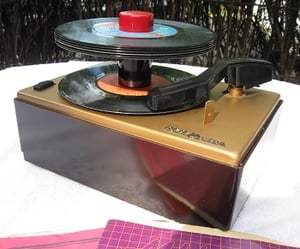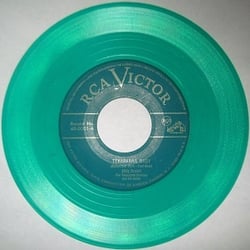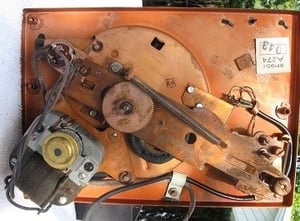Vintage Audio: RCA Victor 45-J-2 Turntable | Telos Alliance
By The Telos Alliance Team on Dec 28, 2015 12:27:16 PM
 Vintage Audio: RCA Victor 45-J-2 Turntable
Vintage Audio: RCA Victor 45-J-2 Turntable
An earlier installment of Found in the Attic examined the ATC-Collins P-190, the first commercially produced cart machine. The point was made that the fast-paced Top-40 format would not have been possible without this device. The same can be said for 45 RPM records. The difference is that the cart machine was designed for radio from day one, while the 7-inch record began as a consumer medium. It wasn't long though, until it became the mainstay of Top 40 music.
Of course, there could not have been 45s without something to play them on. This installment of Found in the Attic looks at a 1950 RCA Victor 45-J-2, one of the first phonographs to play this new media.
The invention of the 7-inch single came out of the post-war economic boom. As the economy raced to meet the pent-up demand for consumer goods, records were one of countless items overdue for a makeover. Ten-inch 78 RPM discs came along in the 1920s, replacing Edison wax cylinders as the new recording medium. They changed very little through the 1940s. They were easily broken, had a horrific level of surface noise, and a short recording time. Arch rivals RCA Victor and Columbia Records were hard at work on a replacement for 78s, and their products went in opposite directions.
In 1948, Columbia unveiled the 33 1/3 RPM long playing record. It played for about 20 minutes per side and was made of vinyl, a much quieter medium than the shellac used in 78s. A year later, RCA responded with the 7-inch 45 RPM record. It too was made of vinyl, but had a short play time of about four minutes. As a clever bit of marketing, RCA used different colored vinyl for different genres of music.
Popular tunes were released on black vinyl. Country records were on green vinyl. Red vinyl was for classical records, while children's recordings were yellow. Orange was designat ed for R & B/Gospel. Semi-classical and instrumental music was pressed on blue vinyl with a blue label. Finally, blue vinyl with a black label was used for international recordings.
ed for R & B/Gospel. Semi-classical and instrumental music was pressed on blue vinyl with a blue label. Finally, blue vinyl with a black label was used for international recordings.
The first commercially available 45 record was Eddy Arnold's "Texarkana Baby." Being a country tune, it was pressed on blue vinyl. This color-coding system didn't last for long, however. Black vinyl was cheaper to manufacture, and economic pressures finally prevailed.
The release of the 7-inch 45 by RCA, and the 12-inch 33 by Columbia within a year of each other kicked off what might be the first format war in recording media. Some, especially those who liked classical music, preferred the 33s, which could record an entire movement of a symphony on one side. The portability of 45s appealed to the younger generation, who were interested in singles from up and coming artists like Elvis Presley, Ricky Nelson and Buddy Holly. Of course, the older generation from the 1920s wanted nothing to do with these new-fangled records, and preferred to stick with their 78s.
The 45 format gained even more importance with the advent of Top 40 radio and the rise of the three-minute song. The entire recording industry soon revolved around the writing, production and marketing of 3-minute hit songs.
Eventually though, some artists, particularly the Beatles, began to chafe at this time restriction. The story is told of John Lennon asking George Martin what the maximum playing time of a 45 record was. Martin did some experimenting, and determined it to be 7 minutes and 11 seconds. No coincidence that this was they playing time for “Hey Jude." The record for the longest-duration 45 however, goes to Richard Harris, whose recording “MacArthur Park” ran for 7 minutes and 20 seconds.
The era of the 45 lasted about 40 years, beginning in 1950, and with a slow fade in popularity beginning in the 1980s. This was due largely to the rise of FM radio and the subsequent end of AM Top 40, as well as the coming of compact discs.
This 45-J-2 was found while dumpster diving in Boston during the early 80s. It has no amplifier. The output from the cartridge goes directly into a cable with an RCA plug. It is intended to be used with the external audio input on radios and other devices of that era. There were similar devices with amplifiers and built-in speakers too.
You can stack about twelve 45s. The speed with which it changes records is astounding. Today's audiophiles and vinyl fans might cringe at how rough the records are treated by the changer, and how hard the needle drops, but that wasn't a concern for teenagers in the 50s and 60s. At less than $1.00 per record, they were almost a disposable medium back then.
The 45 J is cosmetically in good shape for a 65-year old device, although the AC cord and audio cable have been cut off. The years have not been so kind to the rubber shock mounts for the motor or the idler pulleys. They are hard and cracked, the usual fate of vintage rubber. The cartridge doesn't look too healthy either. These things might spell the end of the road for many devices, but there are a surprising number of resources for these old RCA turntables online. You could just send it off to a restoration specialist who will make it good as new, but where's the fun in that? If you want to tear into it yourself, there are a series of  YouTube videos by Chris Cuff that walk you through reworking the RP-190 changer and overhauling the motor. Need those rubber parts? The Voice of Music website has a surprising number of parts for vintage turntables and tape recorders. There's a good chance the original cartridge in the RCA has died. You could replace it with an original RCA part, but these track poorly, sound bad, and can damage stereo recordings. The Phono jack website has info on replacing these vintage cartridges with modern magnetic devices. The difference is sound quality is astounding. And yes, service manuals are available online too.
YouTube videos by Chris Cuff that walk you through reworking the RP-190 changer and overhauling the motor. Need those rubber parts? The Voice of Music website has a surprising number of parts for vintage turntables and tape recorders. There's a good chance the original cartridge in the RCA has died. You could replace it with an original RCA part, but these track poorly, sound bad, and can damage stereo recordings. The Phono jack website has info on replacing these vintage cartridges with modern magnetic devices. The difference is sound quality is astounding. And yes, service manuals are available online too.
If these changers are carefully rebuilt, they will play reliably for another sixty years. An overhaul of this turntable has been added to the infinite to-do list. In the meantime, a descriptive tag was made up for the 45-J-2, and it now goes on display, in time for holiday gatherings.
Telos Alliance has led the audio industry’s innovation in Broadcast Audio, Digital Mixing & Mastering, Audio Processors & Compression, Broadcast Mixing Consoles, Audio Interfaces, AoIP & VoIP for over three decades. The Telos Alliance family of products include Telos® Systems, Omnia® Audio, Axia® Audio, Linear Acoustic®, 25-Seven® Systems, Minnetonka™ Audio and Jünger Audio. Covering all ranges of Audio Applications for Radio & Television from Telos Infinity IP Intercom Systems, Jünger Audio AIXpressor Audio Processor, Omnia 11 Radio Processors, Axia Networked Quasar Broadcast Mixing Consoles and Linear Acoustic AMS Audio Quality Loudness Monitoring and 25-Seven TVC-15 Watermark Analyzer & Monitor. Telos Alliance offers audio solutions for any and every Radio, Television, Live Events, Podcast & Live Streaming Studio With Telos Alliance “Broadcast Without Limits.”
Recent Posts
Subscribe
If you love broadcast audio, you'll love Telos Alliance's newsletter. Get it delivered to your inbox by subscribing below!